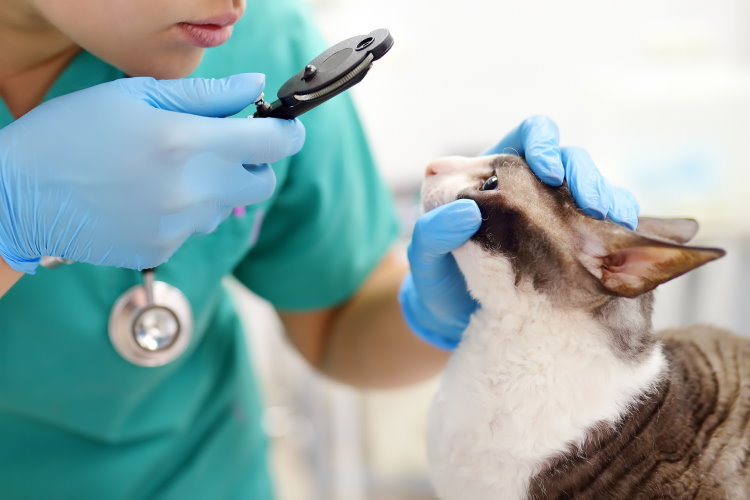Here are the top 10 signs the pet you love may need to see a vet:
1. Loss of Appetite
Most household pets tend to eat a fairly predictable amount of food each day. If your pet shows a serious loss of appetite for a period of 24 hours or more, then this may be a sign of illness or dental disease. Some dogs and cats are fussy or just like sticking to a routine, so a loss of appetite may be related to other factors such as a new type of food or even a new bowl (or position for their bowl) in your home. Regardless, if your pet isn’t eating, you should have them checked by a vet. If your pet insurance policy covers wellness plans (also called preventative pet care or routine pet care coverage), then your provider should cover this.
2. Not Enough (or Too Much) Pooping and Peeing
Like people, pets are creatures of habit. After living with a dog or cat for a long time, you get to know things about their schedule–like what times of day they like to empty their bladder and bowels. If you notice that your pet has been peeing or pooping less than usual, then you should monitor your pet or consult a vet. If your pet goes more than 24 hours without peeing, then book in a checkup immediately as this is potentially a sign of a bladder problem or something more serious. Excessive peeing and pooping can also be a sign of medical issues, so again–monitor your pet and consult your vet if the situation doesn’t improve. Extreme diarrhea requires urgent veterinary attention.
3. Blood in Their Stool
You were probably hoping we’d move on from talking about bowel movements, but while we’re on the topic–blood in your pet’s feces is a top warning sign for illness. The once-off appearance of blood in your pet’s stool may just be a result of constipation or diarrhea caused by stress, dietary changes, or other factors. But if the condition persists or if you notice that your pet’s stool has become darker and more tarry, this could be a sign of a problem in the upper digestive tract such as a parasite or even liver cancer. Blood in your pet’s urine is also a warning sign.
4. Excessive Vomiting
Your pet may vomit because they’ve eaten something that didn’t agree with them or, in the case of a cat, because of hairballs. A cat vomiting a hairball from time to time isn’t a cause for alarm (especially for a long-haired cat such as a Persian), although grooming your cat regularly reduces the amount of fur that can end up in their stomach. However, excessive vomiting–as in anything more than you would normally expect from your pet when healthy–could be a sign of something more sinister, such as intestinal parasites, foreign bodies (e.g. toys, bones) in the gastrointestinal tract, or a liver or kidney condition.
5. Depression, Fatigue or Lethargy

Like humans, pets can suffer from depression, stress, or other mental health-related issues that prevent proper sleep. Going back to what we said earlier about routine: if a pet experiences a major change in their lives such as a change of home, losing a human or animal friend, or having to accommodate a new person or animal in their lives, it may result in them being depressed or lethargic. However, depression, fatigue, and lethargy can also be signs of underlying health issues. Therefore, if you notice your pet just not being themselves, please consult a vet. Again, a wellness or routine pet care plan should cover the costs of a check-up.
6. Inability To Walk or Loss of Balance
If your pet is walking like they’re drunk, it could be a sign of an ear infection or, worse, ataxia. Ataxia can be caused by any number of factors including stroke, brain tumor, trauma, or various infectious diseases. In some cases, the condition can be permanent. If this is the case, then you may need to make changes to support your pet, such as keeping them away from stairs and keeping them away from other animals that are likely to attack.
7. Difficult or Labored Breathing
Like you, your pet may experience heavy or rapid breathing in hot temperatures or when exercising (or really just your dog; cats, rabbits, birds and other pets don’t really do exercise!). But if your pet experiences difficult or labored breathing, this may be a sign of a serious medical issue. Cats and dogs have different telltale signs. For example, it’s normal for dogs to pant and breathe with their mouths open to cool themselves down, but if a cat does it–they’re either seriously stressed, suffering heat exhaustion or coming down with a disease.
8. Excessive Sneezing or Mucus
Sneezing and nasal discharge could be a sign that your pet has an infection, which is of course treatable. However, if you notice excessive mucus–or mucus that is yellow, green, reddish, or brownish–this could indicate a deeper problem, such as a respiratory condition like chronic bronchitis. An occasional sneeze from your cat or dog is nothing to worry about, but persistent, chronic sneezing followed by nasal discharge is a warning sign to see the vet.
9. Eye Injury

There are a lot of different warning signs of eye injury in pets, so let’s just say you should be keeping an eye on your pets’ eyes. Signs of eye injury in a cat, dog or other pet range from the obvious, like their eyelid being closed, to the less obvious like cloudiness in the eye. Once your pet’s sight goes, there’s no getting it back – so treat any signs of eye injury seriously.
10. Lumps
Lumps, swelling and enlarged lymph nodes are all classic warning signs of cancer in pets, just as they are in people. The problem with pets is that lumps can easily be hidden beneath their fur. It pays to check your pet once every so often for lumps. If you’re the sort of pet parent who regularly grooms, pats and plays with your pet anyway, then just keep an eye (or a hand) out for anything abnormal.
Know Your Pet
The common thread running through all our tips is that it pays to know your pet. After you’ve lived for a while, you get to know everything about them: how often they eat, how often they poop, how quickly they breathe, and what their mood is like. If you notice anything out of the ordinary, then consider going for a check-up.
Nadav Shemer specializes in business, tech, and energy, with a background in financial journalism, hi-tech and startups. He writes for top10.com where he discusses the latest innovations in financial services and products.